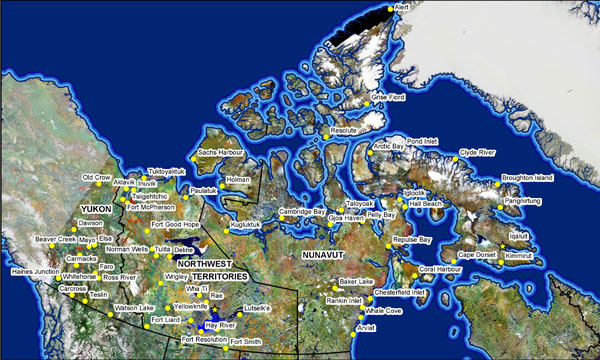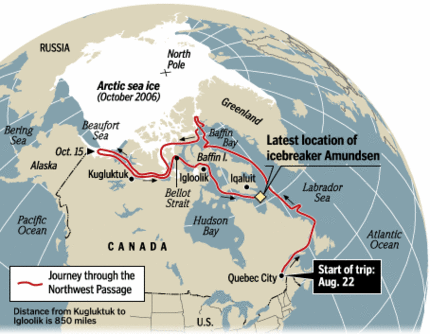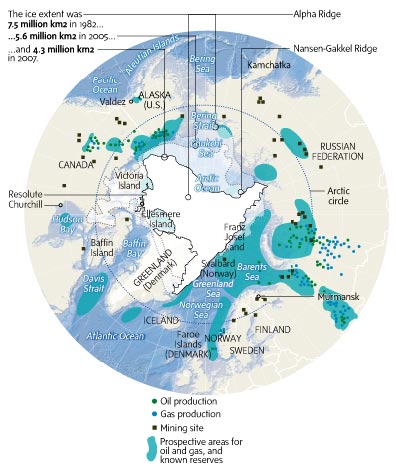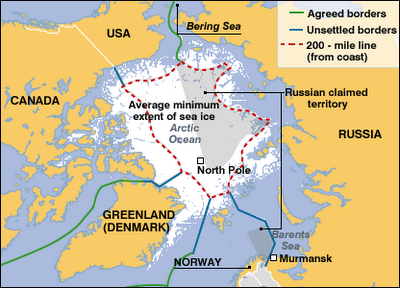
Canada Opens Arctic To NATO, Plans Massive Weapons Buildup
Rick Rozoff
The government of Prime Minister Stephen Harper recently concluded the largest of a series of so-called Canadian sovereignty exercises in the Arctic, Operation Nanook, which ran from August 6-26.
Harper, Minister of National Defence Peter MacKay and Chief of the Defence Staff of the Canadian Forces General Walter Natynczyk visited the nation's 900 troops participating in the "Canadian Forces' largest annual demonstration of Canada's sovereignty in the Arctic" [1] which included "Canada's air force, navy, coast guard...testing their combat capabilities in the frigid cold." [2]
Nanook military exercises were commenced in 2007 when Russia renewed its claims to parts of the Arctic and resumed air patrols in the region after an almost twenty year hiatus. They are complemented by two other Canadian military drills in the region, Operation Nunalivut in the High Arctic and Operation Nunakput in the western Arctic.
Canada is formally involved in territorial disputes with two other Arctic claimants: The United States over the Beaufort Sea lying between Canada's Northwest Territories and Yukon Territory and the American state of Alaska, and Denmark over the Hans Island between Canada's Ellesmere Island and Denmark's Greenland possession on the other end of the Arctic.

Four of the five nations with Arctic claims, all except Russia, are founders of the North Atlantic Treaty Organization whose charter commits member states to mutual military assistance.
With the melting of the polar ice cap and the opening of the fabled Northwest Passage from the Atlantic to the Pacific Oceans for the first time in recorded history, the scramble for the Arctic - reported to contain 30 percent of the world's undiscovered natural gas and 13 percent of undiscovered oil according to last year's U.S. Geological Survey - is under way in earnest. The military value of the navigability of the passage is of even greater and more pressing significance.
The George W. Bush administration's National Security Presidential Directive 66 of January 12, 2009 states:
“The United States has broad and fundamental national security interests in the Arctic region and is prepared to operate either independently or in conjunction with other states to safeguard these interests. These interests include such matters as missile defense and early warning; deployment of sea and air systems for strategic sealift, strategic deterrence, maritime presence, and maritime security operations; and ensuring freedom of navigation and overflight.” [3]
The U.S. insists that the Northwest Passage is open to international navigation while Canada claims it as solely its own. Yet Ottawa has accommodated Washington at every turn while persisting in saber-rattling comments and actions alike vis-a-vis Russia.

Sixteen days after the release of the White House's Arctic directive of last year NATO conducted a two-day Seminar on Security Prospects in the High North in Iceland attended by the military bloc's secretary general, its two top military commanders and the chairman of its Military Committee, and stated that “Clearly, the High North is a region that is of strategic interest to the Alliance.” [4]
Although Canada's territorial disputes in the Arctic are with fellow NATO members the U.S. and Denmark, the three nations have recently coordinated their strategies and in this year's Operation Nanook have for the first time collectively participated in military exercises in the Arctic region.
In mid-July NATO's chief European military commanders, Admiral James Stavridis, Supreme Allied Commander Europe, and General Sir John McColl, Deputy Supreme Allied Commander Europe, arrived in the Canadian capital at the invitation of the nation's military chief, General Walter Natynczyk. The three consulted on "how to take the Alliance forward" and Stavridis "conveyed his latest appraisal of NATO's progress in Afghanistan and commended Canada on its contributions to NATO's efforts around the world." [5]
Canadian Defence Minister MacKay stated almost two years ago: “We are concerned about not just Russia’s claims through the international process, but Russia’s testing of Canadian airspace and other indications...(of) some desire to work outside of the international framework. That is obviously why we are taking a range of measures, including military measures, to strengthen our sovereignty in the North.” [6]
A year ago Canada and the U.S. conducted a 42-day joint Arctic expedition to survey the continental shelf for future bilateral demarcation, following a more modest effort along the same lines in 2008 and followed this year by one with U.S. and Canadian ships from August 7 to September 3. The latter was announced two weeks after a Russian research vessel left St. Petersburg on a mission to delimit the borders of Russia's Arctic continental shelf.
The U.S. State Department described the purpose of this year's expedition: "The mission will help delineate the outer limits of the continental shelf in the Arctic Ocean for the U.S. and Canada, and will also include the collection of data in the disputed area where the U.S. and Canada have not agreed to a maritime boundary." [7] It is being held in the Canada Basin, the Beaufort Shelf, and the Alpha Mendeleev Ridge. The last, along with the Lomonosov Ridge, is the basis of Russian Arctic claims.
On May 14 Canada and Denmark signed a military agreement, a memorandum of understanding pledging to collaborate more closely in the Arctic "through enhanced consultation, information exchange, visits, and exercises," according to the Canadian Forces. [8] The preceding month Denmark deployed a unit to participate in the Operation Nunalivut exercise in the High Arctic.
The Royal Danish Navy sent the HDMS Vaedderen ocean patrol vessel and the HDMS Knud Rasmussen offshore patrol vessel to join the recently concluded Nanook 10 exercises, where they were joined by the U.S. Second Fleet's naval destroyer USS Porter and the U.S. Coast Guard Cutter Alder "for the purpose of exercising and increasing...interoperability with Arctic allies."
As for the Canadian contribution, "The Air Force [provided] air movement and mission support through the CC-177 Globemaster III, CC-130 Hercules, CP-140 Aurora, CH-146 Griffon, and CC-138 Twin Otter aircraft.
"The maritime component [included] Her Majesty's Canadian Ships (HMCS) Montreal, Glace Bay and Goose Bay; and Canadian Coast Guard Ships CCGS Des Groseilliers and CCGS Henry Larsen." [9]
Military personnel involved included "About 900 Canadian troops [who patrolled] parts of the Eastern and Northern Arctic by air, land and sea." Another "600 military personnel from the Danish Royal Navy, the U.S. Navy and the U.S. Coast Guard are also [took] part in the operation." [10]
In the words of Lieutenant Commander Albert Wong of Canada Command, "They're our allies. Collaboration is part of what Canada does." [11]
This year's exercise was based in Resolute Bay in the Nunavut federal territory where the Harper government is building a new army Arctic warfare training center in Resolute and a deep-sea port for the Nanisivik Naval Facility to be constructed on Baffin Island. Canadian Navy Lieutenant Commander Robert Houle said before the event that "2010's military operation will push further north than in past years." [12] That is, north of the Arctic Circle for the first time.
"The US Navy 2nd Fleet, the US Coast Guard and the Royal Danish Navy...joined in the war games in an effort to enhance the allies' capabilities to cooperate in Arctic waters." [13]
In fact the NATO allies collaborated to an unprecedented degree, as "Danish and American vessels" conducted "ocean exercises throughout eastern Nunavut." [14]
After visits by Canada's defense and military chiefs to inspect the multinational war games, Prime Minister Harper arrived in Resolute on August 25, the penultimate day of the 20-day military maneuvers, to - in the words of one of the nation's main news agencies - rally the 1,500 Canadian, American and Danish troops present. [15]
Harper's visit to inspect the exercise occurred only hours after another - potentially dangerous - publicity stunt by his government: Dispatching CF-18 fighter jets (variants of the American F/A-18 Hornet) to allegedly ward off two Russian Tupolev Tu-95 (Bear) strategic bombers patrolling off Canada's northern border, "something the Russian military does frequently." [16]
Harper's press secretary, Dimitri Soudas, "said the two CF-18 Hornet fighters visually identified the two Russian aircraft approximately 120 nautical miles north of Inuvik in Northwest Territories," [17] over international waters.
The timing of the Canadian action, as that of its announcement, was calculated. As was a comparable incident in February of 2009 when then recently installed U.S. President Barack Obama paid his first visit abroad to Ottawa, to meet with Harper, and his host scrambled warplanes to intercept a Russian Tu-95 bomber - on a routine mission thousands of kilometers from the Canadian capital - in a show of bravado and of loyalty to his ally south of the border.
"The Russians said then the plane never encroached on Canadian airspace and that Canada had been told about the flight beforehand." [18]
Last year Canada's prime minister and defence minister made the following comments:
Harper: “We have scrambled F-18 [CF-18] jets in the past, and they’ll always be there to meet them.”
MacKay: “When we see a Russian Bear [Tu-95] approaching Canadian air space, we meet them with an F-18.” [19]
A few days before Operation Nanook began, July 28, Canada also deployed CF-18 fighters against Russian Tu-95 bombers "as debate rage[d] over whether Canada needs the next generation of fighter jets to replace the nearly 30-year-old CF 18s. The Harper government has committed to buying 65 F-35 stealth fighters at a cost of $9 billion. Critics have said such Cold War-type jets are no longer needed." [20]
The same source provided background information concerning what is being fought over:
"Canada is in a race with Russia and other Arctic nations to lay claim to the frozen territory that may hold untold treasures.
"Geologists believe the Arctic shelf holds vast stores of oil, natural gas, diamonds, gold and minerals. A 2007 Russian intelligence report predicted that conflict with other Arctic nations is a distinct possibility, including military action 'in a competition for resources.'" [21]

Regarding the later occurrence on August 24, "The Prime Minister's Office used the incident to promote Ottawa's plan to buy 65 stealth fighter jets for $16 billion." [22]
The discrepancy in (Canadian) dollar amounts is attributable to Ottawa's attempt in May to underestimate the actual cost of the purchase when Defence Minister MacKay said "There is eye-watering technology now available, and a fifth-generation fighter aircraft will be brought to Canada after the year 2017." [23], but failed to disclose the total cost.
When in-service support and other additional outlays are included, the total package will be $16 billion, according to a major Canadian newspaper "one of the most expensive military equipment purchases ever." [24]
In fact the F-35 Lightning II fifth generation stealth fighter project also has been estimated to be "the Pentagon's most expensive weapons program" at a cost of $323 billion for 2,443 of the warplanes. [25]
Last month Defence Minister MacKay confirmed that Canada will buy 65 of the Joint Strike Fighters. At the same time Ottawa announced that the $3 billion Joint Support Ship project will be restarted, as "the military [wants] Joint Supply Ships to be capable of carrying army vehicles and to provide support to ground forces ashore. The ships would also have an air-force element on board, having helicopters and repair facilities for those aircraft. A hospital would also be included on the vessels." [26]
On August 25 Dmitri Soudas, Harper's director of communications, trumpeted the news of the non-encounter between Canadian and Russian military aircraft and laid the bravado on thickly - and not without a purpose. His comments included:
"Thanks to the rapid response of the Canadian Forces, at no time did the Russian aircraft enter sovereign Canadian airspace.
"The Harper Government has ensured our Forces have the tools, the readiness and the personnel to continue to meet any challenges to Canadian sovereignty with a robust response.
"This is true today, it will be true tomorrow and it will be true well into the future.
"The CF-18 is an incredible aircraft that enables our Forces to meet Russian challenges in our North. That proud tradition will continue after the retirement of the CF-18 fleet as the new, highly capable and technologically-advanced F-35 comes into service. It is the best plane our Government could provide our Forces, and when you are a pilot staring down Russian long range bombers, that's an important fact to remember." [27]
The Associated Press reported on the above statement that "Soudas noted...Canada's recent purchase of 65 F-35 Joint Strike Fighter jets from U.S. aerospace giant Lockheed Martin Corp. The $8.5 billion purchase, one of the biggest military equipment purchases in the country's history, was due to be debated at a parliamentary defense committee hearing on Wednesday. [August 25, the date of Soudas' comments]. The jets will replace the Air Force's aging fleet of CF-18s." [28]
According to a Canadian journalist:
"This week...we learned that the Cold War is not, in fact, over and that Russia remains an active threat in the north....Harper's press spokesman, noted Sovietologist Dimitri Soudas, explicitly turned the Russian flyby into an argument for a $16-billion, sole-sourced upgrade of Canada's fighter-plane fleet." [29]
Canada requires an adversary to justify large-scale arms acquisitions. In the past three years it has bought and leased 120 Leopard tanks from Germany and the Netherlands for the war in Afghanistan. It has purchased and used Israeli-made Heron drones (unmanned aerial vehicles) for the same war theater and beyond, one of which crashed near a military base in Alberta last month knocking out power lines.
It has also acquired Chinook, Griffon and Mi-8 helicopters for NATO's war in South Asia, where it has deployed 2,830 troops and where 151 of its soldiers have been killed.
The Polar Epsilon spaced-based satellite project is being developed for the Arctic, and while in Resolute Bay on Wednesday Prime Minister Harper reiterated that the RADARSAT Constellation Mission, a three-spacecraft fleet of satellites that is the centerpiece of Polar Epsilon, "will provide the Canadian military with daily coverage of Canada's land mass and ocean approaches 'from coast-to-coast-to-coast, especially in the Arctic.'" [30]
In June defense chief MacKay disclosed that Canada will spend over $30 billion "to build 28 large vessels for the Canadian Coast Guard and navy, as well as 100 smaller ships." [31]
Canada is, as NATO's top military commander Admiral Stavridis remarked in Ottawa last month, providing the Western military bloc and the Pentagon indispensable services around the world. In the Arctic as much as if not more than anywhere else.
Related articles:
Canada: Battle Line In East-West Conflict Over The Arctic
http://rickrozoff.wordpress.com/2009/08/31/canada-battle-line-in-east-west-conflict-over-the-arctic
Encroachment From All Compass Points: Canada Leads NATO Confrontation With Russia In North
Loose Cannon And Nuclear Submarines: West Prepares For Arctic Warfare
Canada: In Service To The Pentagon And NATO At Home And Abroad
Notes
1) Xinhua News Agency, August 7, 2010
2) Agence France-Presse, August 25, 2010
3) NATO’s, Pentagon’s New Strategic Battleground: The Arctic
Stop NATO, February 2, 2009
http://rickrozoff.wordpress.com/2009/08/26/natos-pentagons-new-strategic-battleground-the-arctic
4) Ibid
5) North Atlantic Treaty Organization
Supreme Headquarters Allied Powers Europe
July 11, 2010
6) Canwest News Service, September 12, 2008
7) Russian Information Agency Novosti, July 27, 2010
8) Nunatsiaq News, May 24, 2010
9) Xinhua News Agency, August 7, 2010
10) CTV, August 25, 2010
11) Nunatsiaq News, June 16, 2010
12) CBC News, August 3, 2010
13) Agence France-Presse, August 25, 2010
14) CBC News, August 18, 2010
15) Canadian Press, August 25, 2010
16) CTV, August 25, 2010
17) Xinhua News Agency, August 25, 2010
18) Associated Press, August 25, 2010
19) Encroachment From All Compass Points: Canada Leads NATO Confrontation With
Russia In North
Stop NATO, August 5, 2009
20) Toronto Sun
Quebec Media, Inc. Agency
July 30, 2010
21) Ibid
22) CTV, August 25, 2010
23) Canwest News Service, May 28, 2010
24) Ottawa Citizen, July 12, 2010
25) PBS Newshour, April 21, 2010
26) Ottawa Citizen, July 12, 2010
27) CBC News, August 25, 2010
28) Associated Press, August 25, 2010
29) Susan Riley, The Russians aren't coming
Ottawa Citizen, August 27, 2010
30) Agence France-Presse, August 25, 2010
31) Xinhua News Agency, June 4, 2010
Stop NATOhttp://groups.yahoo.com/group/stopnato
Blog site:http://rickrozoff.wordpress.com/
To subscribe, send an e-mail to:rwrozoff@yahoo.com
orstopnato-subscribe@yahoogroups.com
Daily digest option available.
Aug. 29, 2010

